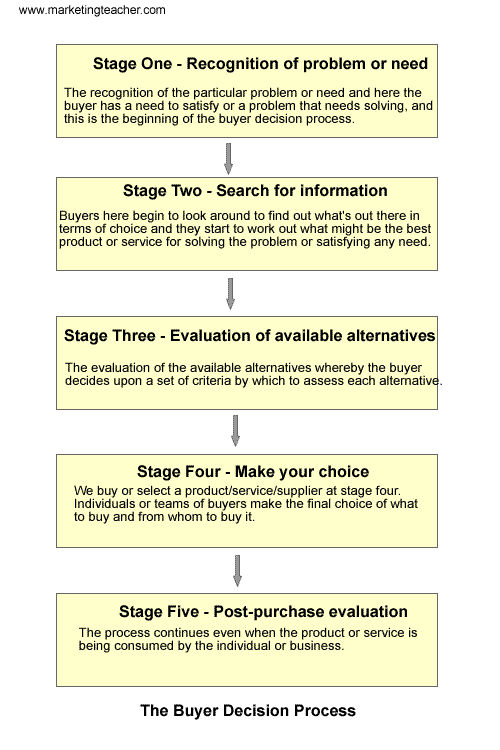The buying process
The buyer decision process represents a number of stages that the purchaser will go through before actually making the final purchase decision. The consumer buyer decision process and the business/organisational buyer decision process are similar to each other. Obviously core to this process is the fact that the purchase is generally of value in monetary terms and that the consumer/business will take time to actually assess alternatives. For FMCG (Fast Moving Consumer Goods) the purchase decision process tends to be shorter/quicker, and for habitual purchase behaviour or repeat purchases the decision process is short-circuited.
An example of a cellular handset will make it clear
The first stage is where you feel the need for a handset
Why do you need a handset?
You want to replace your existing handset as you are bored, it is outdated, a new phone launched in the market has better features etc
More importantly you need to be connected to friends, relatives, parents and other 'well wishers', or for surfing the net, be on social media 24X7 etc
the second stage is where you speak to your friends and surf the Internet looking at alternatives, which represent stage two – or your information search. As a buyer you might visit a local cellphone store and speak to the sales staff to help you complete stage three, i.e. your evaluation of alternatives. Stage four is the selection of product and you go and make your final decision and buy your smartphone from a local store or using an e-commerce website. Stage five involves your post-purchase evaluation whereby you use the phone and have a positive, negative or mediocre experience of the product. If it doesn’t satisfy your needs you take action and more importantly you’ll tell others of your problems. If you’re pleased with the product, you will tell your friends and this will influence stage two (their information search) when they decide to buy a cellphone.
Stage One

An example of a cellular handset will make it clear
The first stage is where you feel the need for a handset
Why do you need a handset?
You want to replace your existing handset as you are bored, it is outdated, a new phone launched in the market has better features etc
More importantly you need to be connected to friends, relatives, parents and other 'well wishers', or for surfing the net, be on social media 24X7 etc
the second stage is where you speak to your friends and surf the Internet looking at alternatives, which represent stage two – or your information search. As a buyer you might visit a local cellphone store and speak to the sales staff to help you complete stage three, i.e. your evaluation of alternatives. Stage four is the selection of product and you go and make your final decision and buy your smartphone from a local store or using an e-commerce website. Stage five involves your post-purchase evaluation whereby you use the phone and have a positive, negative or mediocre experience of the product. If it doesn’t satisfy your needs you take action and more importantly you’ll tell others of your problems. If you’re pleased with the product, you will tell your friends and this will influence stage two (their information search) when they decide to buy a cellphone.
Stage One
Stage one is the recognition of the particular problem or need and here the buyer has a need to satisfy or a problem that needs solving, and this is the beginning of the buyer decision process.
Stage Two
Stage two is where we begin to search for information about the product or service. Buyers here begin to look around to find out what’s out there in terms of choice and they start to work out what might be the best product or service for solving the problem or satisfying any need.
Stage Three
Stage three sees the evaluation of the available alternatives whereby the buyer decides upon a set of criteria by which to assess each alternative.

Stage Four
We buy or select a product/service/supplier at stage four. Individuals or teams of buyers make the final choice of what to buy and from whom to buy it.
Stage Five
Interestingly the process does not stop at the point of purchase because there is a stage five called the post-purchase evaluation. The process continues even when the product or service is being consumed by the individual or business. So if it doesn’t meet your needs or solve your problem you can take action to improve the product or service. Your actions at this point might inform other potential buyers who would be keen to hear about your experiences – good or bad.
Comments
Post a Comment